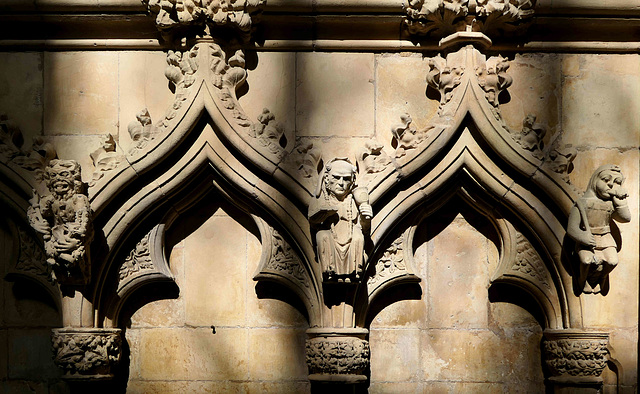
Woodwoses
and other wild men and women
Whalley - St Mary and All Saints
The Church of St Mary and All Saints dates from the 13th century. A church probably existed on this site in Anglo-Saxon times. There are three Anglo-Saxon crosses in the churchyard. The "Church of St Mary held in Wallei" was mentioned in the Domesday Book of 1086. Most of the present church was built in the 13th century, replacing a simpler structure which likely had an aisleless nave and chancel. The tower was added in the late 15th century.
The ruins of the Cistercian abbey of Whalley Abbey, founded in 1172, are very close by. The last abbot, John Paslew, was involved in the "Pilgrimage of Grace" against the church policy of King Henry VIII and was subsequently executed. Following the sequestration of the monastery by the Crown in 1537, it was dissolved in 1545 and fell into disrepair towards the end of the 17th century.
The stalls in the parish church may originate from the former Cistercian abbey.
Beverley Minster
The town's origins date back to the 7th century. The first known building was a church founded by John of Beverley (+ 721), the later canonized Bishop of York. Around 850, the monastery was dissolved by the invasion of the "Great Heathen Army" of Vikings, and the town became part of the new Kingdom of Jorvik. However, the veneration of John of Beverley ensured that the region's population grew steadily until the 10th century.
The Archbishops of York encouraged the development of Beverley. The town, along with York, Ripon, and Southwell, became one of the most important Christian centers in England.
After the Norman conquest of England, many pilgrims flocked to Beverley after hearing of the miracles performed by John of Beverley. Many people in the north of England rejected Norman rule. The Normans then ravaged the towns of Yorkshire. Beverley, however, was spared due to the sanctity of the place.
Tradition attributes the refoundation of the monastery as a collegiate church of secular canons to King Æthelstan. The establishment of a significant minster and its privileges occurred gradually, but by the early 11th century, Bishop John's tomb had become an important pilgrimage center, as he was canonized in 1037, and his cult encouraged the growth of a town around the minster.
A fire in 1188 seriously damaged the minster and the town. A complete rebuilding was required. During the construction, a new lantern tower over the eastern crossing designed to illuminate the shrine of St John was under construction, but it collapsed in 1219 necessitating a partial rebuild of the church. By 1260 the retrochoir, choir, chapter house, transepts, and crossing were complete. Overwhelmingly tall and spacious, and speaking to the increasing skills of the stonecarvers, this new work was radically different from the old Saxon and Norman structure it replaced. It was the product of the novel structural systems and artistic development that together define the Gothic style brought to England in the late 12th century.
A large orchestra and some very strange people populate the walls inside.
A woodwose on the left
Jump to top
RSS feed- Latest items - Subscribe to the latest items added to this album
- ipernity © 2007-2025
- Help & Contact
|
Club news
|
About ipernity
|
History |
ipernity Club & Prices |
Guide of good conduct
Donate | Group guidelines | Privacy policy | Terms of use | Statutes | In memoria -
Facebook
Twitter



